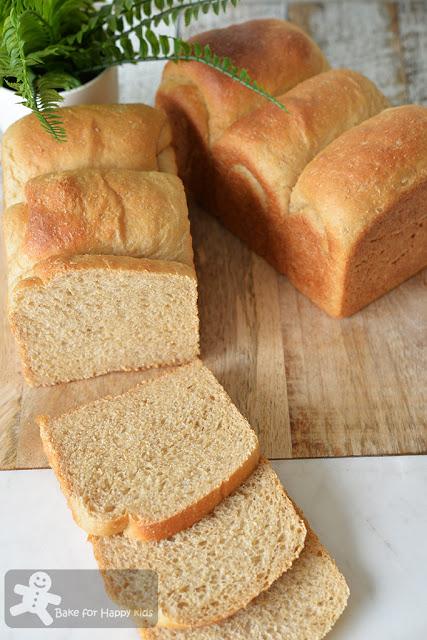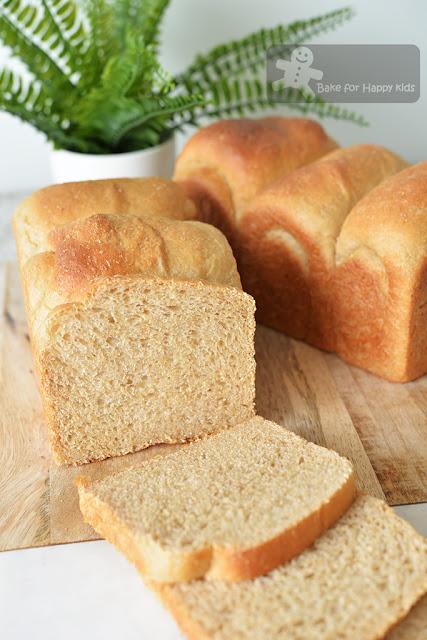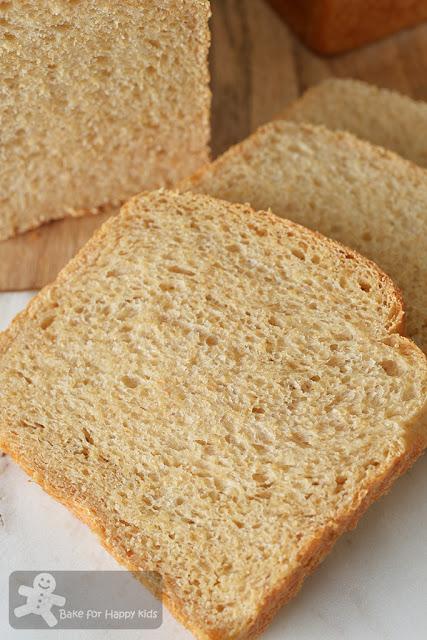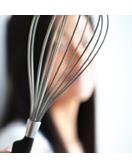... but why am I so excited about this?
Prior this bake, I have baked wholemeal breads at here, here, here and here but never bake any wholemeal bread with 100% wholemeal flour because I know that the 100% wholemeal breads are NOT typically soft and delicious like the all-white and semi-white breads.
Why???
Do you know that wholemeal flour and all-white flour absorbs water very differently? If you add the same amount of water into the same amount of wholemeal and white flour, you will see that the wholemeal flour tends to absorb more water making the wholemeal dough significantly drier and tougher than the white flour dough.
What to do? To tackle this problem, some recipes and breadmakers heat the wholemeal flour with liquid to allow the wholemeal bran to soften and absorb more liquid. Is this heating and resting step really effective? YES!!! I will show you...

Soft 100% Wholemeal Maple Sandwich Bread
Do you know or have you tried this highly reviewed 100% wholemeal bread recipe at King Arthur Flour at here and here?
It is a brilliant recipe but I have enhanced it even more...
1) Instead of mixing wholemeal flour with lukewarm water at about 37°C / 100°F, I did my mixing with warm water at about 70°C / 160°F.
2) Instead of allowing the wholemeal dough to rest for 20 to 30 minutes, mine was rested for more than 18 hrs in a fridge.
3) Do not add maple syrup and oil in this hydration step because syrup and oil will affect the overall solubility of water and will make the flour absorb less liquid in this step.
All step (1), (2) and (3) will make the wholemeal flour to absorb the liquid maximally as the heating and extra hydration time will soften the bran even further.
4) To be absolutely precise and reproducible, I don't do cup measurements and prefer to weigh my ingredients in grams.
5) Based the maximum amount of hydration suggested in the original recipe, I have used the maximum amount of 400g water to mix 650g wholemeal flour to make two loaves of 10 x 20 cm breads.
6) Although the recipe says that I can use either honey or molasses or maple syrup to bake these breads, I would prefer to use maple syrup and avoid using honey and molasses. Due to the fact that honey and molasses have higher sugar content, they tends to burn easily and will potentially dry out the bread. Whereas, maple syrup with less sugar content is less viscous and has a boiling point that is quite similar water (about 100°C) and will not cause the bread to burn so easily. So... yes to maple syrup! No to honey and molasses!
Is everything all sorted for this bake? Not really!
Although the protein content in wholemeal flour is pretty high as compared to most bread flour, they do not contain as much gluten as most bread flour, resulting these 100% wholemeal breads not to rise as tall as most white or even semi-white breads.
To clarify further, these 100% wholemeal breads are moist and soft and even the crust is soft even though they won't be tall and fluffy like most white and semi-white breads.
To tackle this problem, you can add gluten flour to boost the strength of the wholemeal flour but I don't think it is really necessary.
Plus, you might wish to know that these breads won't rise well enough to form square sandwich breads if you want to bake these bread in pullman pans. So bother to cover your bread pans with the lids!

Proudly presenting my 100% wholemeal SOFT sandwich breads

They are delicious with a sweet maple fragrance.

They are so soft that even their crust are soft too!!!
Can't believe that these breads are made with 100% wholemeal flour.
Here's the video showing how I baked these soft wholemeal breads.
"Hey sweetie! Are these wholemeal bread soft enough?" I asked my son after feeding him a small piece of the bread and waited anxiously for his answer.
"Hmmm... I can smell and taste the maple but I can also taste the wholemeal in these bread." said my son with a strict and critical face.
"Pass?" I asked again to re-confirm any potential answer.
"Alright." It was a reluctant yes because I know that my son doesn't want me to bake wholemeal breads for him too often. Hmmm... I know my son too well. And, if there is no rejection from him, I know that these breads are clearly soft enough!!!
Like my kids-friendly recipes? To get the latest updates, you can follow me at either my Facebook at here or here or my Instagram @zoebakeforhappykidsHere's the recipe that is adapted from King Arthur Flour at here and here.
Make two 10 cm x 20 cm loaves
400g water, warm at about 70°C (160°F)650g wholemeal / whole wheat flour
45g milk powder
4g salt
100g maple syrup, at room temperature - Do not use maple-flavoured syrup! Flavoured syrup is not real maple!
a few drops of maple extract, optional
75g neutral tasting vegetable oil
2 1/2 tsp dry yeast
vegetable oil spray to grease the loaf pans
extra bread flour for dusting and shaping but please use the minimal amountOn the day before the bake:
Combine warm water, wholemeal / whole wheat flour, milk powder and salt. Knead briefly to form a pliable dough. Transfer dough into an airtight container and place the container in a fridge for 18-24 hrs. This step will allow the flour to absorb the liquid and soften the bran further.On the day of bake:
Take wholemeal mixture out of the fridge and place it in a warm and humid place for at least 1 hr or until the dough is thawed to room temperatureAdd maple syrup, maple extract (optional), oil, small pieces of the wholemeal dough and yeast into the breadmaker or the mixing bowl of an electric mixer.
If you are using a breadmaker to knead and prove, use "dough" setting to mix and knead dough for 30 mins or until the dough is elastic and allow the dough to prove for 1 hr. If you are using an electric mixer with an hook attachment to knead, mix at low speed until a soft dough forms. Then, increase to the next higher speed and continue to knead for at least 25 mins or until the dough is elastic. Cover the dough and allow the dough to prove in a warm and humid place for about 1 hr or until doubled in size.
To shape the dough into bread loaf:
Grease 10 x 20 cm loaf pans with vegetable oil spray. Divide dough into into 6 equal portions. Shape each portion of dough into smooth balls. Allow them to rest at room temperature for about 10 mins.Using a lightly floured rolling pin, roll each portion into long and flat oval shape (about 20 cm) on a lightly floured non-stick surface. Use your fingers to pick one shorter side of the dough and tuck and roll the dough like a Swiss roll. Use a rolling pin to flatten and roll the dough into a long rod shape. Then, pick one shorter side of the dough and roll it like a Swiss roll again. Repeat this rolling step with the remaining portions of dough.
Place three rolled dough with their seams side down into the each prepared pan. Press the top of the dough lightly to form an even surface. Allow the dough to prove in a warm and humid place for another 1 hr or until the dough is going to reach the maximum height of the loaf pan.
Bake bread in a preheated 180°C (350°F) oven for 25 mins or until the bread are thoroughly baked. Cover the breads very loosely with foil if the breads turn brown too quickly after baking for 15 mins and continue to bake until the bread are thoroughly baked. Remove breads from the loaf pans and transfer immediately onto a wire rack to cool completely before slicing.
To store, wrap tightly in plastic wrap and keep at room temperature for 2-3 days or freeze in serving portions for 2-3 months.
Happy Baking
Please support me and like me at Facebook...
